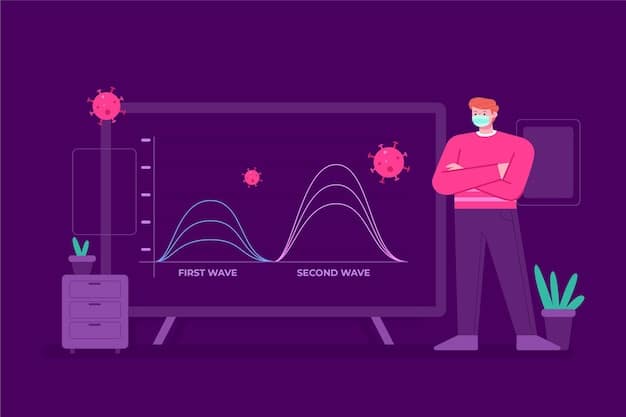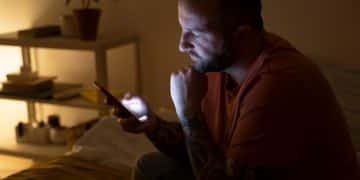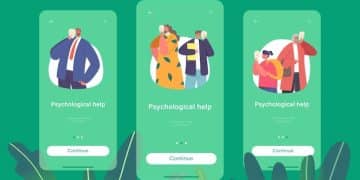Screen Time Alert: New Study Reveals Anxiety Spike in Young Adults

New research reveals a concerning link between increased screen time and a 20% rise in anxiety levels among young adults in the US, highlighting the urgent need for awareness and balanced digital habits.
The digital age has brought unprecedented access to information and connectivity, but a recent study raises serious concerns about its impact on mental health. The breaking news highlights a significant link between increased screen time and a 20% rise in anxiety among young adults, demanding a closer look at our digital habits and their consequences.
The Screen Time-Anxiety Connection: Understanding the Study
This groundbreaking research sheds light on a potential correlation between excessive screen usage and heightened anxiety levels in young adults. It aims to understand the dynamics between digital consumption and mental well-being.
Study Methodology
The study involved a diverse group of young adults across the United States. Researchers meticulously tracked their daily screen time habits using various devices, including smartphones, tablets, and computers.
Key Findings
The data revealed a striking trend: as screen time increased, so did the prevalence of anxiety symptoms. Participants who spent more than six hours a day on screens were 20% more likely to report symptoms of anxiety compared to those with lower screen time.
- Increased screen time correlates with higher anxiety levels.
- Young adults spending over six hours daily on screens are at higher risk.
- The study highlights the need for further research on digital habits.

The study’s findings underscore the importance of understanding how our digital habits influence our mental state. It suggests a need for greater awareness and mindful practices around screen usage, especially among young adults.
Why Are Young Adults More Vulnerable?
Young adults navigate a unique set of challenges, often amplified by the digital landscape. Factors include developmental stage, social pressures, and the pervasive nature of social media.
Developmental Stage
The brain continues to develop well into the early twenties, making young adults particularly susceptible to external influences. Excessive screen time during this critical period can disrupt neural pathways and impact emotional regulation.
Social Pressures
Social media platforms often present idealized versions of reality, leading to social comparison and feelings of inadequacy. Young adults may also experience cyberbullying or fear of missing out (FOMO), further contributing to anxiety.
The Role of Social Media
Social media has become an integral part of modern communication, especially for young adults. While it offers many benefits, it also presents challenges to mental health.
- Constant connectivity can lead to increased stress and anxiety.
- Exposure to unrealistic portrayals on social media can harm self-esteem.
- Cyberbullying and online harassment are prevalent issues that significantly impact mental well-being.
The combination of these factors paints a picture of increased vulnerability among young adults. Recognizing these challenges is the first step toward developing strategies to mitigate the negative effects of screen time on mental health.
The Impact on Daily Life and Mental Well-being
The rise in anxiety among young adults due to increased screen time can manifest in various ways, affecting their daily routines and overall mental well-being. These effects include:
Sleep Disturbances
The blue light emitted from screens can interfere with the production of melatonin, a hormone that regulates sleep. As a result, young adults may experience difficulties falling asleep and staying asleep, leading to chronic sleep deprivation.
Social Isolation
While screens offer virtual connection, excessive screen time can lead to decreased face-to-face interactions. This social isolation can exacerbate feelings of loneliness and anxiety.
Physical Health Issues
Prolonged screen time often involves sedentary behavior, which increases the risk of obesity, cardiovascular problems, and other physical health issues. These physical ailments can further contribute to mental distress and anxiety.

These combined effects of screen time can significantly impact the quality of life for young adults, highlighting the importance of promoting balanced digital habits.
Practical Strategies for Reducing Screen Time
Taking proactive steps to reduce screen time can have a positive impact on mental health. Here are several practical strategies that young adults can implement:
Set Daily Limits
Establish specific timeframes for screen usage, encouraging breaks and alternative activities. Apps that track and limit screen time can be useful tools for maintaining these healthy limits.
Create Tech-Free Zones
Designate certain areas or times, like the bedroom or mealtimes, as tech-free zones. This practice encourages face-to-face interactions and reduces the temptation to constantly check devices.
Engage in Alternative Activities
Replace screen time with activities that promote physical and mental well-being, such as exercise, reading, or spending time outdoors.
- Engage in Physical Activity: Regular exercise can significantly reduce anxiety and improve overall mood.
- Practice Mindfulness and Meditation: These techniques can help young adults manage stress and anxiety.
- Seek Social Support: Interacting with friends and family provides emotional support and combats feelings of isolation.
By implementing these strategies, young adults can foster a healthier relationship with technology and experience significant improvements in their mental well-being.
The Role of Parents and Educators
Parents and educators play a crucial role in shaping healthy digital habits among young adults. Their influence and guidance are essential in promoting balanced screen time and fostering mental well-being.
Early Intervention
Establishing healthy digital habits early in life can prevent excessive screen time and its associated risks. Parents can set screen time limits, monitor online activities, and lead by example through their own responsible screen usage.
Education and Awareness
Educators can incorporate digital literacy programs into school curricula, teaching young adults about the potential impacts of screen time on mental health. They can also promote awareness campaigns to encourage responsible digital behavior.
Open Communication
Creating an open and supportive environment where young adults feel comfortable discussing their concerns is crucial. Parents and educators can foster this environment by actively listening, offering guidance, and providing resources for mental health support.
- Encourage open dialogue about the effects of social media.
- Provide access to mental health resources and professionals.
- Promote a culture of understanding and empathy.
By working together, parents and educators can create a supportive network that empowers young adults to make informed decisions about their digital consumption and prioritize their mental well-being.
Future Research and Prevention
As the digital landscape continues to evolve, ongoing research is crucial to understand the complexities of screen time and its effects on mental health. Future studies should focus on:
Long-Term Effects
Investigate the long-term impacts of chronic screen time on brain development, emotional regulation, and cognitive function.
Effective Interventions
Develop and evaluate interventions that promote balanced digital habits and mitigate the negative effects of screen time on mental health.
Diverse Populations
Examine the association between screen time and anxiety across diverse cultural and socioeconomic backgrounds to tailor interventions to specific needs.
This research will help inform prevention efforts and ensure that young adults receive the support they need to navigate the digital age while safeguarding their mental well-being. By staying informed and proactive, we can create healthier digital environments that promote mental resilience and overall wellness for future generations.
| Key Point | Brief Description |
|---|---|
| 📱 Screen Time & Anxiety | New research links increased screen time to a 20% rise in anxiety among young adults. |
| 🧠 Vulnerability Factors | Young adults’ developmental stage and social pressures increase their vulnerability. |
| ⏰ Practical Strategies | Setting limits, creating tech-free zones, and alternative activities can reduce screen time. |
| 👨👩👧👦 Role of Influencers | Parents and educators play a crucial role in shaping healthy digital habits and providing support. |
Frequently Asked Questions
▼
Generally, more than six hours a day on screens is considered excessive and may increase the risk of anxiety. It is important to balance screen time with other activities.
▼
Signs include increased anxiety, sleep disturbances, social isolation, and decreased engagement in real-life activities. Also, feeling restless or irritable when away from screens.
▼
Parents can set screen time limits, encourage alternative activities, and create tech-free zones in the home. Also, lead by example with their own screen habits.
▼
No, some screen time is more harmful than others. Passive consumption (like endlessly scrolling) is often more detrimental than active engagement like learning or creating content.
▼
Young adults can seek help from mental health professionals, school counselors, or online resources such as support groups and mental health apps tailored to their specific needs and concerns.
Conclusion
The new research linking increased screen time to a surge in anxiety among young adults underscores the need for greater awareness and proactive measures. By understanding the risks, implementing practical strategies, and fostering supportive environments, we can help young adults navigate the digital age while safeguarding their mental well-being.





